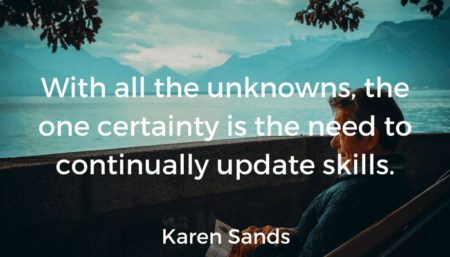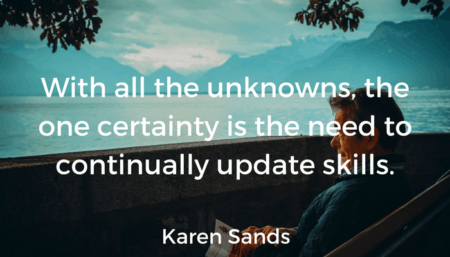This post is the companion to a Voice America interview with Karen Sands, Leading GeroFuturistSM, Amazon #1 Best-Seller Author, Fire Cracker Speaker, All-Around Game Changer and Thought Leader on the Longevity Economy aired on VoiceAmerica “Innovative Leaders Driving Thriving Organizations” Navigating the Graying Demographic: Rock Your Age and Manage Intergenerationally. We will continue this conversation with both Karen Sands and Virginia Macali in future conversations.
I often talk about the changes in technology and how they will change our work lives. For readers who are around fifty years of age, if you make it to sixty-seven, you are likely to live into your mid-80s. This is particularly interesting because I am in my 50s and wonder for myself what my next twenty years will look like if I live another thirty years. In talking about personal choices, I also examine the trends regarding baby boomer retirement and levels of unemployment.
According to the Pew Research Center, “As the year 2011 began on Jan. 1, the oldest members of the Baby Boom generation celebrated their 65th birthday. In fact, on that day, today, and for every day for the next 19 years, 10,000 baby boomers will reach age 65. The aging of this huge cohort of Americans (26% of the total U.S. population are Baby Boomers) will dramatically change the composition of the country. Currently, just 13% of Americans are ages 65 and older. By 2030, when all members of the Baby Boom generation have reached that age, fully 18% of the nation will be at least that age, according to Pew Research Center population projections.”
Add to that, the unemployment rate for 2018 is expected to be 3.9 percent according to The Balance.
Artificial intelligence and technology will change the composition of jobs—in many cases requiring more tech savvy roles to manage the automation of prior manual jobs. In other cases, AI will eliminate jobs that focus on routine tasks.
With all the unknowns, the one certainty is the need to continually update skills. I spoke with the President of Junior Achievement of Central Ohio, Mike Davis, about this trend. According to Mike, his focus after reaching age fifty has been to continually update his skills to stay relevant and move his organization ahead and leveraging the changes in our ecosystem to make the greatest impact.
Given the data, I wanted to share what I am thinking about this information for myself and my clients. When contemplating what I would like my life to look like, I break the questions into four categories:
- What do I value and how do I find meaning in my life? Specifically, how do I continue to find meaning in my life and work? Personally, I find a great deal of fulfillment in my professional work both within my company, teaching in universities, and in board work. I hope to continue to participate in each of these roles over the next 20 years.
- What do I do with my time? If I value the work and my sense of purpose based on the work, I need to maintain my level of knowledge and continue to grow, especially since my personal brand is associated with innovating how we lead. To be true to what I say I do, I will need to continue to invest significant time in learning. I will also need to explore working alternatives, particularly when traveling, that match my energy level. This will mean leveraging technology to manage whenever possible.
- What do organizational cultures support? It seems that many organizations are open to older workers as long as they are able to keep up with younger workers. I plan to promote environments that build productive interactions across age groups. This could be co-mentoring or other structures that allow multiple age groups to support one another’s growth and development.
- What do organizational systems support? Organizations need to promote ongoing education to ensure their workers can continue to perform their roles at ever increasing levels over time. As workers plan to retire later, it is incumbent on both the employees and the organizations to update skills, so the work is performed to necessary standards. An opportunity for companies who can be creative is to promote flexible working arrangements for older workers who no longer want to work a standard 40+ hour schedule. This could include working remotely, job sharing, or working on a task-related basis like “gig” workers.
What stands out for me as I consider my own future, is that I must maintain my current level of impact in the world, which is where I find great meaning and value in my life. I need to continue to invest in my own skill development. I also need to stay healthy. While we haven’t discussed this element, it is imperative for me to attend to my health and manage my stress so I am able to continue working at a high level of performance.
To become a more innovative leader, please consider our online leader development program. For additional tools, we recommend taking leadership assessments, using the Innovative Leadership Fieldbook and Innovative Leaders Guide to Transforming Organizations, and adding coaching to our online innovative leadership program. We also offer several workshops to help you build these skills.
About the Author
Maureen Metcalf, CEO and Founder of Metcalf & Associates, is a renowned executive advisor, author, speaker, and coach whose 30 years of business experience provides high-impact, practical solutions that support her clients’ leadership development and organizational transformations. Maureen is recognized as an innovative, principled thought leader who combines intellectual rigor and discipline with an ability to translate theory into practice. Her operational skills are coupled with a strategic ability to analyze, develop, and implement successful strategies for profitability, growth, and sustainability.





